Name any part of your Goldie’s eyes, and our team will tell you about several diseases associated with them. Yes, our furry friends are susceptible to a wide range of eye conditions—too many to be listed here. Instead, we want to keep pet parents informed about the most common Golden Retriever eye problems.
In this quick read, let’s familiarize you with the most typical canine eye diseases, their symptoms, and how to deal with them. Read until the end to protect your pet’s vision!
Causes of Golden Retriever Eye Diseases
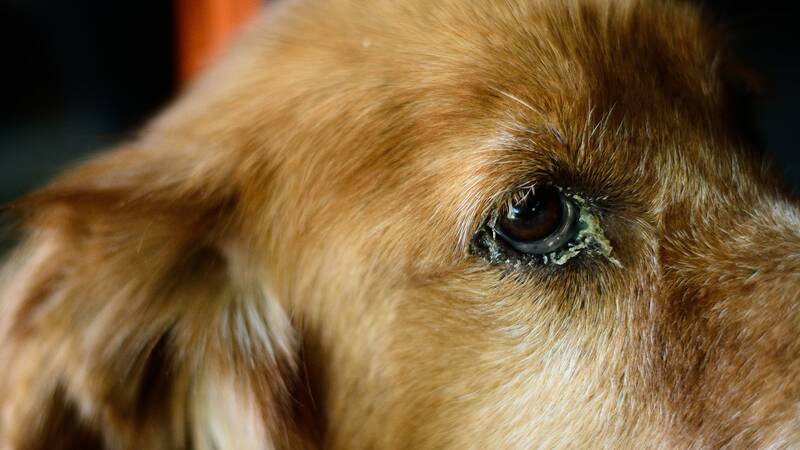
Before we familiarize you with the most common Golden Retriever eye problems, let’s discuss the causes first. Here are some of the most common factors that contribute to eye diseases:
- Genetics: Many eye problems in Golden Retrievers have a hereditary component. Breeds like Golden Retrievers can be predisposed to certain eye conditions due to their genetic makeup.
- Age: As dogs get older, they become more susceptible to various eye problems, just like humans. Conditions such as cataracts and glaucoma are more common in senior dogs.
- Environmental factors: Irritants like dust, pollen, or chemicals can cause eye inflammation and contribute to the development of eye problems.
- Trauma: Accidents or injuries to the eye area can lead to immediate problems or increase the risk of future eye issues.
- Infections: Bacterial or viral infections can affect the eyes, leading to conditions like conjunctivitis or more severe issues if left untreated.
- Nutritional deficiencies: A lack of certain vitamins and minerals in your dog’s diet can impact overall eye health and potentially lead to eye problems. Ensure you use the best adult dog food for golden retrievers to help them always healthy.
Common Eye Diseases in Golden Retrievers
Now, we will give you a closer look at the five most prevalent eye diseases affecting this beloved breed:
1. Cataracts in Golden Retrievers
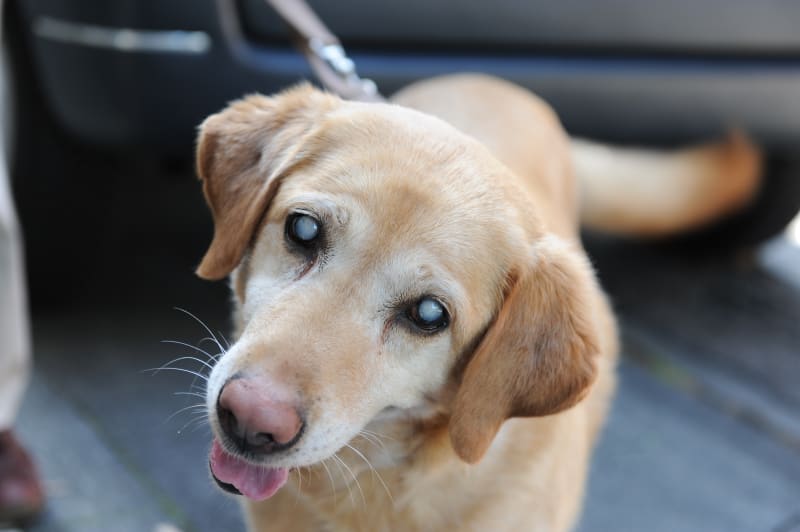
Cataracts are one of the most common eye problems in Golden Retrievers. Imagine looking through a foggy window – that’s what the world might look like to a dog with cataracts. This condition is characterized by clouding of the eye’s lens, which can significantly impair vision.
You might notice your Goldie bumping into objects more frequently or seeming hesitant in dimly lit areas. If you look closely at their eyes, you may see a cloudy or opaque appearance, especially in the center of the eye. This cloudiness can range from a small dot to covering the entire lens.
Cataracts can be caused by genetics, age-related degeneration, diabetes, or even trauma to the eye. While it might be concerning to see these changes in your pet’s eyes, the good news is that cataracts are often treatable. The most common treatment is surgical removal of the affected lens, sometimes followed by an artificial lens implantation. With proper care and timely intervention, many dogs with cataracts can regain much of their vision.
2. Keratitis
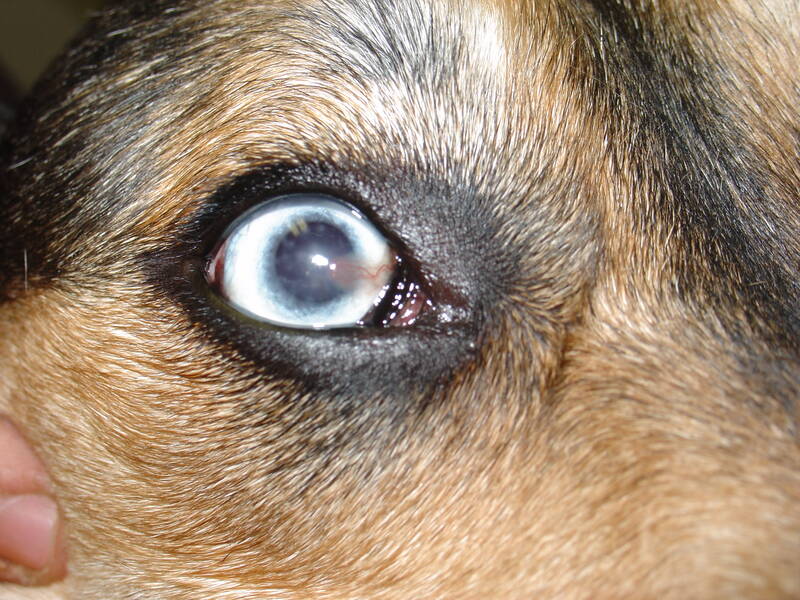
Keratitis is another eye condition that can affect Golden Retrievers. It’s an inflammation of the cornea – the clear, outer layer of the eye. If you’ve ever had a scratch on your eye, you might have an idea of how uncomfortable keratitis can be for your furry friend.
You might notice your dog’s eye looking red and swollen. They might be squinting or keeping the affected eye closed. Excessive tearing is another common sign – you might see more “eye boogers” than usual.
Keratitis can have various causes, including bacterial or viral infections, allergies, or even autoimmune disorders. Sometimes, it can result from trauma to the eye, like a scratch from a playful encounter gone wrong.
Treatment for keratitis depends on the underlying cause. Your vet might prescribe antibiotics or antiviral eye drops to fight off infections. Anti-inflammatory medications can help reduce swelling and discomfort. In severe cases, especially if there’s deep damage to the cornea, surgery might be necessary. With prompt treatment, most dogs recover well from keratitis.
Read more >> Do Golden Retrievers Shed? How To Reduce It?
3. Progressive Retinal Atrophy (PRA)
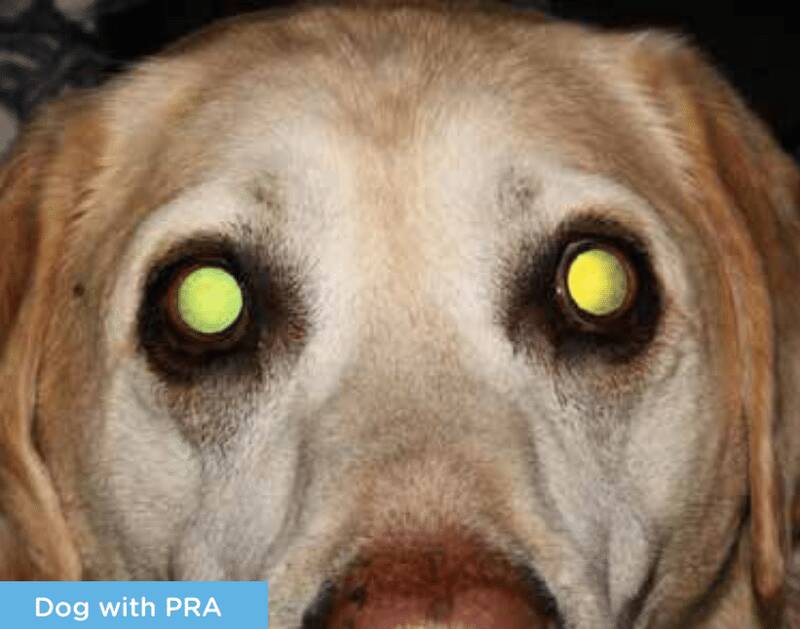
Progressive Retinal Atrophy, or PRA, is a genetic condition that affects the retina – the part of the eye that captures light and sends visual information to the brain. It’s like a camera’s sensor slowly losing its ability to capture images.
The first sign of PRA is often night blindness. You might notice your Goldie becoming hesitant to go out after dark or bumping into things in low light. As the condition progresses, you might see their pupils becoming more dilated, even in bright light. Eventually, PRA can lead to complete blindness.
Unfortunately, there’s currently no cure for PRA. It’s caused by a genetic mutation, which is why responsible breeding practices are so important. While we can’t reverse the progression of PRA, we can help our furry friends adapt. This might involve keeping their environment consistent, using night lights, and focusing on other senses like hearing and smell for enrichment.
4. Dacryocystitis

Dacryocystitis might sound like a mouthful, but it’s simply an infection of the tear ducts. These tiny tubes drain tears from the eyes into the nose, keeping everything flowing smoothly. When they get blocked or infected, it can cause discomfort for your Golden Retriever.
You might notice excessive tearing – it might look like your dog is crying all the time. There might be discharge from the eye, ranging from clear to yellowish. You might also see swelling near the inner corner of the eye, right where the tear duct is located.
Blocked tear ducts, bacterial infections, or even congenital abnormalities can cause dacryocystitis. Treatment usually involves a combination of antibiotics, both oral and topical, to fight the infection. Your vet might also need to flush the tear ducts to remove any blockages. In chronic cases, surgery might be necessary to create a new drainage pathway.
5. Conjunctivitis
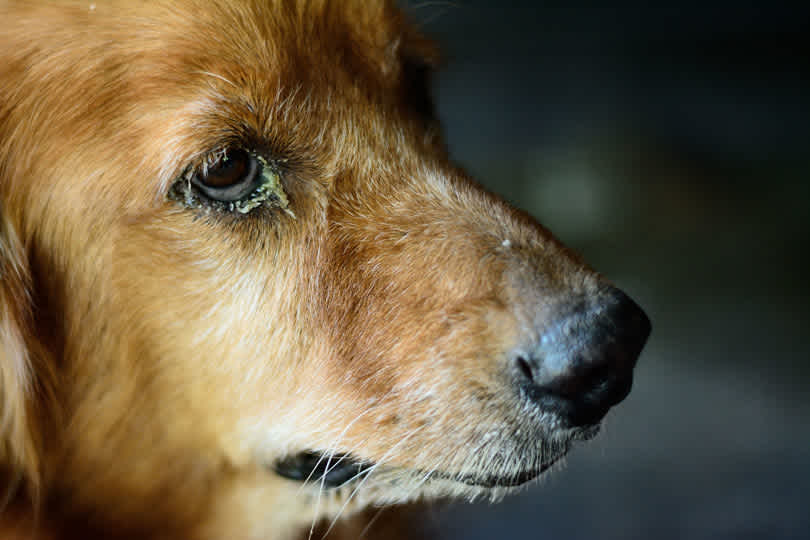
Conjunctivitis, commonly referred to as “pink eyes,” is an inflammation of the conjunctiva, which are the tissue layers that line the eyes’ whites and eyelids.
When this condition occurs, you will notice your dog’s eye tissue looking swollen, red, or pink. There might be discharge, which can be clear, yellow, or even green.
When coming alone, conjunctivitis might be caused by bacterial or viral infections. It can also be a result of allergies or irritants like dust or smoke. According to veterinarians, though, it’s more commonly a sign of an underlying condition, such as canine herpes virus or corneal ulcer.
Since there are many possible reasons for this condition, vets will determine the treatment based on the root cause. They will prescribe antibiotic eye drops of ointment if the problem is bacterial infection, and antihistamines if it’s an allergic reaction. As long as it is not a symptom of a serious illness, most cases of conjunctivitis can be resolved quickly with proper care.
Preventing Eye Problems in Golden Retrievers
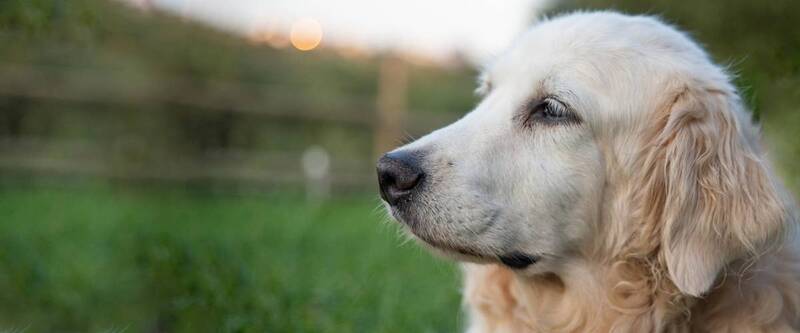
Prevention is always better than cure. Here are some strategies to maintain your Golden Retriever’s eye health:
Assess Your Dog’s Eyes Often
Ironically, many pet parents spend time with their Golden Retrievers daily but still don’t realize their eye problems until it’s too late. Our team of veterinarians offers 2 useful tips to assess your dog’s eyes daily:
- Look into their eyes when your Golden Retriever plays in a well-lit space. Healthy eyes should be clear and vibrant, surrounded by a white area. Both pupils should be similar in size. If you notice a dull eye surface, cloudiness, uneven pupil size, or discharge that’s abnormal in color, it’s time to schedule a vet visit.
- Gently roll your thumb down your Goldie’s lower eyelid to examine the lining. A healthy lining should be pink, not white or red.
Diet and Supplements
Humans benefit from a diet rich in specific nutrients that promote eye health, and so do our furry friends. After discussing with the vets, we have a list of silver bullets for improving your dog’s eyesight:
- Carrots: Being a rich source of beta-carotene, carrots are a super food for good vision. The body will transform this component into vitamin A, which is essential for preserving eye health, improving night vision, and supporting the eyes’ ability to adjust to different brightness levels.
- Blueberries: Packed with antioxidants and vitamin C, blueberries shield your dog’s eyes from oxidative stress, protecting them from age-related eye problems. If you have a senior Goldie at home, consider adding this fruit to their diet.
- Eggs: So your dog prefers protein to veggies? We have the vision-boosting food for them as well! Egg yolks are high in minerals that promote eye health, including zinc, vitamin A, zeaxanthin, and lutein.
- Salmon and fish oil: This combo is a classic, and for good reasons: they are an excellent source of omega-3 fatty acids. It’s a powerful antioxidant that protects dogs’ vision and prevents age-related vision loss.
Daily Eye Hygiene and Care
When you notice discharge around your Goldie’s eyes, there’s no need to freak out just yet. We produce watery and mucous discharge when waking up, too, which is perfectly normal. However, unlike us, their eyes are surrounded by fur that traps these discharges.
Since Golden Retrievers are medium-length-haired, some eye flush and a cotton ball daily are enough to keep their eyes clean. If your Goldie suffers from chronic eye problems, though, you might want to trim the area around their eyes to prevent excess buildup.
Read more >> Are Golden Retrievers Hypoallergenic? Your Essential Guide
Regular Health Check-Ups
Schedule regular veterinary visits:
- Annual eye examinations: Regular eye check-ups help detect potential problems early, allowing for prompt treatment.
- Screening for breed-specific eye conditions: Regular screening for common Golden Retriever eye issues, such as cataracts or progressive retinal atrophy, ensures timely intervention.
Avoiding Risk Factors
Minimize exposure to potential hazards:
- Use protective eyewear during high-risk activities
- Avoid exposing your dog to smoke or other airborne irritants
- Provide adequate shade outdoors to reduce UV exposure
Conclusion
Golden Retriever eye problems can be challenging, but with the right care and knowledge, many of these conditions can be effectively managed. Regular check-ups, maintaining a healthy lifestyle, and paying close attention to any changes in your dog’s eyes are essential for preserving their ocular health. Early detection is key to successful treatment, especially as many eye issues in Golden Retrievers have a genetic component.
Managing these problems often requires a combination of home care and professional veterinary treatment. Prevention through a balanced diet, good hygiene, and consistent vet visits is crucial. By staying proactive, you can help your Golden Retriever maintain healthy eyes and enjoy a high quality of life for years to come.

With years of expertise as a pet care writer, I’ve acquired a specific interest in Golden Retrievers, who are one of the most popular and beloved dog breeds. Although I do not own a Golden Retriever, my extensive study and talks with pet professionals enable me to offer useful and reliable articles for dog owners. My work on this website covers important areas such as diet, grooming, and training for Golden Retrievers. My goal is to provide readers with the information they need to keep their dogs healthy and happy.

